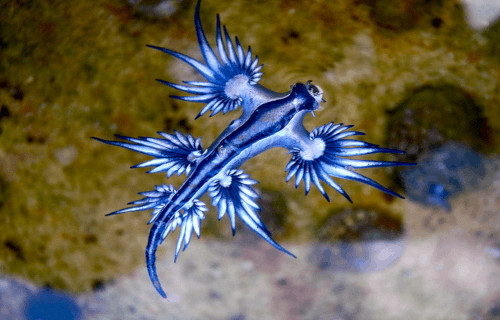
CCL: https://bit.ly/1jxQJMa
We sincerely hope that you enjoy your reading of this article about 6 Startling Marine Slugs. These creatures rank as startling because many of them defy expectations. When people hear the word slug, many often expect to find visually unappealing species.
Many of these fascinating animals do present quite lovely forms and colors. Regardless of what one thinks of their appearance, though, Nature created each of these 6 Startling Marine Slugs for a reason, and therefore they remain worthy of respect and appreciation.
Spanish Shawl
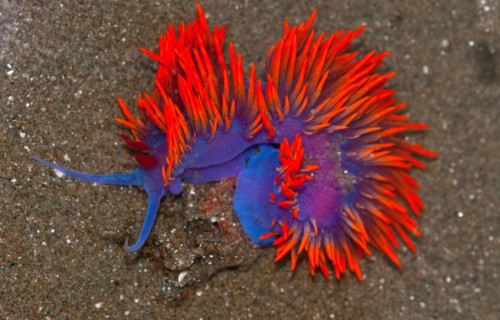
CCL: http://bit.ly/2zDnGC2
Spanish Shawl Facts
- Leading off this listing of 6 Startling Marine Slugs is the highly appealing animal known as the Spanish Shawl.
- Amazingly, the appealing term for the creature serves as the generally accepted common name for an especially colorful type of sea slug. Its scientific name, however, remains that of the tongue-twisting term of Flabellinopsis iodinea.
- Regardless of which of these terms one uses to refer to it, though, one fact remains unchallenged. That has to do with the appearance of the awesome creature. This fabulous species represents one of the most brilliant of its kind known to mankind.
- This truly amazing variety of marine gastropod mollusk further conceals an incredible attribute. That holds true due to the fact that, unlike most creatures, this little beauty actually evolved as entirely hermaphroditic in its nature.
- In this manner, evolution provided this marvel of Nature with an advantage over many other creatures around the world. The delicate-seeming Spanish Shawl appears to also have population base that’s both sufficient and relatively stable.
- The IUCN, therefore, currently has no listing for it on the organization’s Red List of Threatened Species. Nonetheless, it must be considered to be facing potential threats to its existence. Likely, the greatest of these perils consists of climate change.
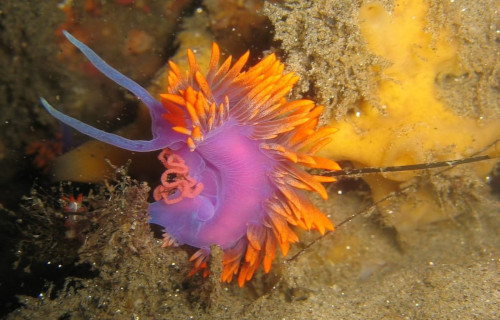
CCL: http://bit.ly/2P4R3Ic
Spanish Shawl Physical Description
To be certain, without doubt, the amazing Spanish Shawl truly mesmerizes those fortunate enough to see it. The species nonetheless does not do so due to sheer physical size. That’s obvious because of the fact that it remains a physically diminutive creature.
This even holds true in relation to its many related species around the globe. This member of its genus, however, doesn’t stand out because of its size. It does so because of the fact that, unlike many others, this nudibranch shows no sign of sexual dimorphism.
As a result, the mature individuals of both genders achieve approximately the same measurements. This results in the attainment of an average body length of roughly 2.75 in (7 cm). That actually ranks it as slightly smaller than average for its kind.
Plus, mature specimens of both sexes of the Spanish Shawl display the same patterns of color. In point of fact, this consists of brilliant shades of three specific colors. Those include a bright purple body, a bright neon orange cerata, and usually scarlet colored rhinophores.
- Kingdom: Animalia
- Phylum: Mollusca
- Class: Gastropoda
- Order: Aeolidioidea
- Family: Flabellinidae
- Genus: Flabellinopsis
- Species: F. iodinea
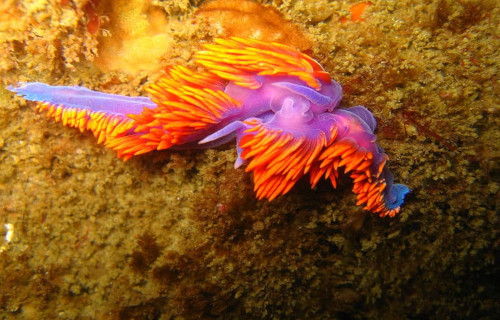
CCL: http://bit.ly/2IjEG4n
Spanish Shawl Distribution, Habitat, and Ecology
Quite unfortunately, the gorgeous Spanish Shawl presently inhabits a comparatively restricted range of habitation. That’s due to the most regrettable fact that the awesome gastropod only appears along the west coast of North America.
More precisely, though, scattered populations of this small but magnificent creature have been sighted over much of that range. This includes as far north as British Columbia, in the country of Canada, to as far south as the Baja region, in the country of Mexico.
However, even within this highly limited zone of habitation, it stays concentrated. The stunning animal has very specific requirements for where it lives. This remains true since this beautiful creature also prefers to inhabit regions of relatively shallow water.
These specific areas, though, most typically occur very near the shore, wherever they appear. Hence, individuals of this species occur from intertidal areas to depths of as much as 130 ft (39.6 m). Most nevertheless prefer shallower depths.
Much like its roughly 3,000 related species, the awesome Spanish Shawl also evolved as a carnivore. In its case, though, its prey principally consists of such creatures as anemones. It nonetheless also likes to consume the eggs of other mollusks.
Meanwhile, its own primary predator might surprise many of you. In point of fact, this is actually another nudibranch, the Navanax. Finally, although the species did surprisingly evolve as fully hermaphroditic, self-fertilization rarely happens.
Black Sea Hare
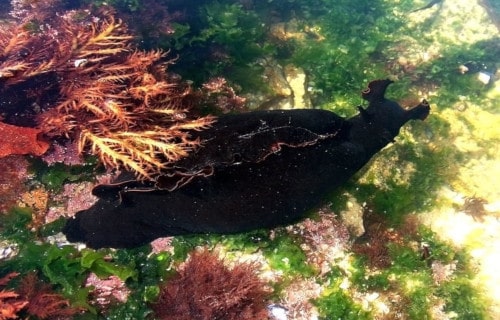
CCL: https://bit.ly/2K0yxJp
Back Sea Hare Facts
- Next up in this article about 6 Startling Marine Slugs is the highly distinctive species known as the Black Sea Hare.
- Impressively, the truly stunning creature represents an extremely large species of animal known as a sea slug. For the moment, a total of roughly 3,000 recognized varieties of such creatures exist. That’s an astounding number.
- This creature forms the largest all of presently known related species. Yet, its superior size alone does not constitute its only difference from related creatures. Nature, it would seem, chose to set it apart from its brethren in more ways than one.
- This holds true, in part, because unlike most of its brethren, this remarkable sea slug actually does not produce ink. In addition to this, its evolved defensive measures, which are quite impressive, also set it apart from similar creatures.
- Since it lacks ink, the invertebrate protects itself from predators by making its flesh undesirable to them. While other species also do this, it approaches it from an unusual angle. This occurs due to the fact that its principle food source contains natural toxins.
- The magnificent Black Sea Hare, however, evolved a natural immunity to such poisons. As a result of its consumption of the animals, the toxin builds up concentrations in its flesh sufficient to make it lethal to potential predators.
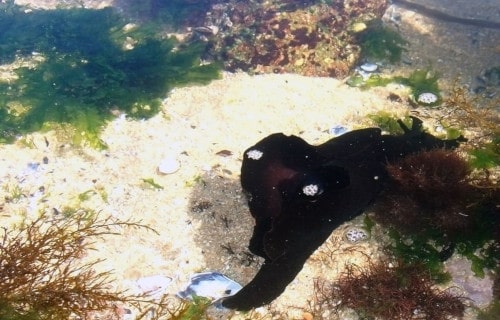
CCL: https://bit.ly/2K0yxJp
Black Sea Hare Physical Description
Most notably, the fabulous variety of sea slug known as the Black Sea Hare remains a truly impressive physical specimen of its kind. That’s true because of the fact that this stunning creature ranks as a true giant, at least compared to species sharing its Order.
The trait of sexual dimorphism plays no noticeable natural role for this invertebrate, however. That holds true because it evolved as a simultaneous hermaphrodite. Due to this, each individual remains both male and female throughout its life.
To begin with, mature individuals of this particular species attain an average size of about 15 in (38 cm) in length. Exceptional specimens do occasionally occur, though. Some individuals, therefore, reach total lengths of as much as 39 in (99 cm).
This natural wonder also grows to a relatively astounding weight for its kind. This remains true because an average weight for this slug equals roughly 15 lb (6.8 kg). Yet those same exceptional specimens sometimes reach a weight of as much as 31 lb (14 kg).
The relatively enormous body of the Black Sea Hare further generally presents a dark black in coloring. Yet, occasionally different shades sometimes appear. And lastly, the body itself remains comparatively firm in relation to similar animals.
- Kingdom: Animalia
- Phylum: Mollusca
- Class: Gastropoda
- Order: Heterobranchia
- Family: Aplysiidae
- Genus: Aplysia
- Species: A. vaccaria
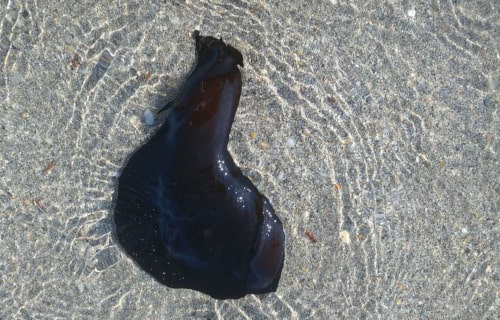
CCL: https://bit.ly/2ufSWYU
Black Sea Hare Distribution, Habitat, and Ecology
Most unfortunately for lovers of Nature, the incredible Black Sea Hare has a restricted habitat range. In point of fact, it only inhabits the coastal waters of two areas. These consist of the coast of California, in the United States, and Baja California, Mexico.
Much like others of its kind, this truly remarkable animal also has an entirely herbivorous diet. In its case, however, the creature has also evolved a highly specific one. In fact, it only feeds on kelp and brown seaweed, being immune to its toxins.
This fabulous and quite surprising animal also typically grows quite rapidly. That at least holds true in relation to its relatives. In point of fact, an average weight gain per day among individuals monitored equaled nearly an astonishing 5 grams per day.
Finally, being hermaphroditic in nature also gives the Black Sea Hare a decided edge over competing species. Due to this remarkable evolutionary trait, any two individuals can reproduce together. But sadly, its average lifespan on equals roughly one year.
Sea Swallow

CCL: https://bit.ly/1jxQJMa
Sea Swallow Facts
- The third choice for inclusion in this compendium of 6 Startling Marine Slugs is the amazing species man calls the Sea Swallow.
- First of all, the short and appealing term perfectly serves as one of several common names for a truly remarkable form of sea slug. This fabulous variety of marine gastropod also goes by numerous other names, however.
- These alternate terms include such names as the blue angel, blue glaucus, blue dragon, blue sea slug, and the blue ocean slug, among others. Meanwhile, its scientific name remains that of the hard to pronounce Glaucus atlanticus.
- Regardless of the name one uses for it, this creature never fails to fascinate. Its original identification as a species occurred in 1777. This identification came at the hands of the renowned German naturalist and ethnologist, Johann Georg Adam Forster.
- Quite fortunately, the amazing Sea Swallow appears to be maintaining a population base that’s both sufficient and relatively stable. The IUCN, therefore, currently has no listing for the animal on its Red List of Threatened Species.
- The unique species must nonetheless be considered to be at some potential risk, from several factors. One of these happens to be habitat loss. The most pressing of these, though, most likely consists of the ongoing effects of climate change.
Sea Swallow Physical Description
The Sea Swallow relies upon its appearance to stand out from related species. This holds true due a combination of two factors. Firstly, it presents a dazzling appearance to the world. Secondly, this nudibranch ranks as a smaller than average member of its Family.
This surprising statement rings true due to one specific statistic that might be surprising to some people. To be more precise, that’s the fact that this fascinating marine invertebrate only attains an average adult length measuring roughly 1.2 in (3 cm).
Much like the majority of related species, this impressive animal shows no sign of the physiological trait of sexual dimorphism. Given this, mature adults of both genders of the Sea Swallow typically show a silvery gray on one side, and pale blue on the other.
However, several dark blue stripes do generally appear on the head of the amazing creature. It also possesses a flat, tapering body shape. Attached to that body, it also displays a total of six appendages. These develop into finger-like structures.
- Kingdom: Animalia
- Phylum: Mollusca
- Class: Gastropoda
- Order: Nudibranchia
- Family: Glaucidae
- Genus: Glaucus
- Species: G. atlanticus
Sea Swallow Distribution, Habitat, and Ecology
Quite fortunately for itself, and those who appreciate Nature, the amazing Sea Swallow appears to inhabit an extremely extensive range. This occurs because evidence indicates that the awesome gastropod inhabits every ocean of the world.
Nevertheless, the greatest concentrations of its population does seem to be concentrated in a few specific, though separated, regions of the globe. That’s true because of the fact that this particular nudibranch appears in the greatest numbers in three areas.
These include the coastal regions of South Africa, eastern Australia, and Europe. Yet, smaller concentrations also thrive in many temperate and tropical waters. It does, however, appear to have a decided preference for areas of the open ocean, away from land.
Some distinctive characteristics further separate the Sea Swallow from other similar species, however. Firstly, and somewhat interestingly, at least scientifically, all members of this species develop as hermaphrodites, having both male and female reproductive organs.
Secondly, this animal floats upside down on the ocean surface, aided by the presence of a gas-filled sac in its stomach. Thirdly, though, its prey generally consists of creatures larger than itself. This trait alone amply serves to distinguish it from similar creatures.
The preferred prey of this animal includes creatures such as the Velella, the Portuguese Man O War, and the Violet Snail. It has the ability to feed on toxic species due to its natural immunity. Finally, it actually stores the toxins of its prey in its body, for its own use.
California Blue Dorid
California Blue Dorid Facts
- The fourth entry into this compilation of 6 Startling Marine Slugs, the California Blue Dorid, appears in that spot only due to random selection.
- Perhaps most notably, the informative term for this animal serves as the common name for a particularly lovely form of marine slug. However, it also bears the difficult to pronounce scientific name of the Felimare californiensis.
- While the names we use to speak of it may change, though, one fact remains apparent. That’s the fact this creature remains exceedingly rare. Unfortunately, though, researchers possess relatively little reliable data about the amazing species.
- This lamentable situation occurs mainly due to its sheer scarcity. That’s true since this quite obviously limits opportunities for observation and study. By 1984, the species had disappeared completely from the northern part of its natural range.
- However, since the year 2003, a few individual specimens of the species have been spotted in that area once again. As a result of this, scientific studies now remain ongoing, in attempts to learn more about this rare species.
- For the moment, the IUCN has no listing for the California Blue Dorid. Any such listing would appear on the organization’s Red List of Threatened Species. This regrettably occurs due to simple insufficient data, not because of hopeful scenarios.
- Many people nonetheless presently believe the remarkable species to be at risk. This belief occurs due to several factors. More specifically, these potential threats primarily consist of habitat loss, and the ongoing effects of climate change.
California Blue Dorid Physical Description
First of all, it must be pointed out that, although the gorgeous California Blue Dorid stands out, it does not do so due to sheer physical size. That holds true, in point of fact, due to the fact that the gastropod ranks as only a roughly average-sized member of its genus.
More precisely, adult specimens of this species, at least of the limited number studied, attain an average length of about 3.5 in (9 cm). Unlike many sea creatures, the California Blue Dorid displays no noticeable degree of the principle of sexual dimorphism.
Individuals of both genders generally show patterns of extremely bright, vivid color. As its name suggests, though the exact pattern varies among individuals, a deep blue remains paramount. Other colors nonetheless include vibrant shades of orange, and light blue.
- Kingdom: Animalia
- Phylum: Mollusca
- Class: Gastropoda
- Order: Nudibranchia
- Family: Chromodorididae
- Genus: Felimare
- Species: F. californiensis
California Blue Dorid Distribution, Habitat, and Ecology
Quite regrettably, the stunning California Blue Dorid appears to have evolved as native to an extremely restricted portion of the world. That’s because this limited zone of habitation only seems to include a very confining range extending from Monterey Bay to Baja, California.
More precisely, though, this region follows the Eastern Pacific Coast of the United States, in North America. Further complicating its situation, the species also developed to require very specific environmental conditions for it to thrive.
That’s because the invertebrate only lives in the shallow ocean waters, close to the shore. Quite naturally, this severely restricts its possibilities for expansion. This region itself, by it very nature, further remains especially vulnerable to environmental changes.
Not surprisingly, like its related species, the California Blue Dorid, evolved as a strict carnivore. In its case, however, its diet consists of various dysideid sponges. For the moment, due to limited data, this appears to be its sole source of nourishment.
Meanwhile, its own naturally evolved predators, if any, remain completely undetermined. Given its moderate toxicity, however, researchers expect its predators to be relatively few. Scientific research into this subject nonetheless presently remains ongoing.
Spanish Dancer
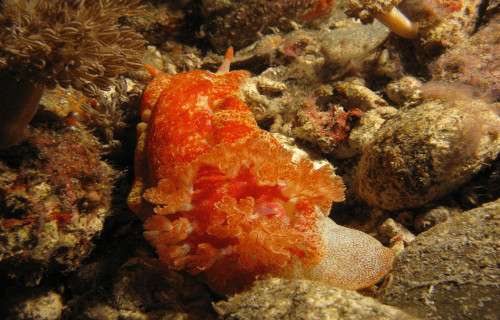
CCL: https://bit.ly/1ryPA8o
Spanish Dancer Facts
- Our fifth choice to appear in this article about 6 Startling marine Slugs is the remarkable creature known as the Spanish Dancer.
- The truly visually stunning animal ranks as a comparatively large and brilliantly colored species of beautiful nudibranch. The remarkable creature also goes by the tongue-twisting scientific name of the Hexabranchus sanguineus.
- The distinctive swirling motion that the fascinating animal uses to swim serves as the source of the vividly descriptive common name. This incredible species further appears to be completely unique among the many types of sea slugs.
- Not only does this creature crawl across the ocean floor, it also has the ability to swim freely through the ocean. In fact, to date, it remains the only known species of nudibranch to possess this ability. The reason for this ability also baffles researchers.
- Quite fortunately, for the moment, the Spanish Dancer appears to have a sufficient and relatively stable population base. Therefore, the IUCN does not presently have a listing for it on the organization’s Red List of Threatened Species.
- Like many species, it nonetheless faces serious threats to its continued existence. Primarily, like many other species, it remains vulnerable to the ongoing effects of climate change. Other concerns, such as habit loss, also play a role, though.
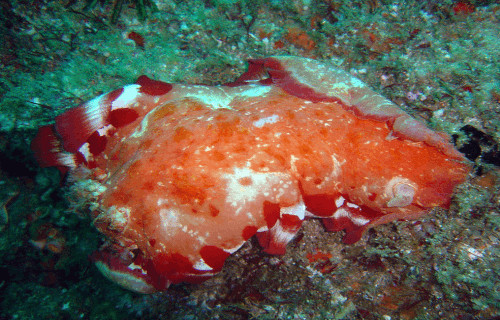
CCL: https://bit.ly/1p2b8Ke
Spanish Dancer Physical Description
Perhaps worthy of note is the fact that, like other forms of nudibranch, the stunning Spanish Dancer evolved as fully hermaphroditic in nature. The physiological principle of sexual dimorphism therefore does not apply to this particular animal.
As a result, this marine gastropod mollusk must rely upon factors other than physical appearance to stand out from its many related species around the world. Fortunately for it, the Spanish Dancer ranks as one of the largest of all currently known nudibranches.
That holds true due to the fact that mature specimens attain lengths of as much as 35.4 in (90 cm). Yet, a more common length equals about 11.8 in (30 cm). Meanwhile, individuals mainly show a brilliant shade of red, with orange shadings. But, a yellow variant does exist.
- Kingdom: Animalia
- Phylum: Mollusca
- Class: Gastropoda
- Order: Heterobronchia
- Family: Hexabranchidae
- Genus: Hexabranchus
- Species: H. sanguineus
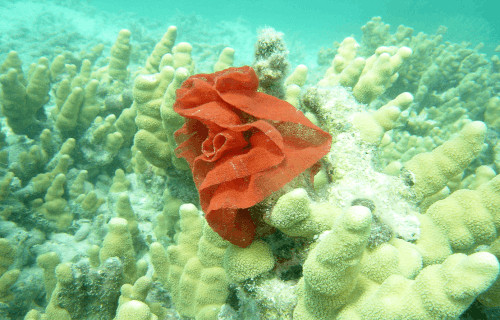
CCL: https://bit.ly/1ryPA8o
Spanish Dancer Distribution, Habitat, and Ecology
Quite fortunately, the beautiful Spanish Dancer appears to inhabit a moderately broad range of habitation. That’s true because evidence indicates that it lives in specific portions of both the Red Sea and the Indo-Pacific Ocean.
More precisely, though, this dazzling gastropod commonly appears in the waters off the coasts of Australia and Africa. It also thrives in the waters around Japan and Hawaii. Plus, this amazing form of life also has very specific preferences for its choice of where to live.
That situation holds true due to the fact that the amazing ocean denizen typically prefers to live in an unusual habitat. That’s rocky areas and coral reefs. This wonder also prefers this environment to be filled with many sponges and places of shelter.
However, it also only lives in regions with depth of no more than 164 ft (50 m). The reason the Spanish Dancer prefers to have numerous sponges in its area is simple. To be precise, it evolved as a highly specialized predator that feeds almost exclusively on sponges.
This amazing form of life has also developed a unique form of defense in that it routinely preys upon toxic jellyfish and sponges, being immune to their toxins. The animal then assimilates the poison into its own body and uses it in its own defense.
California Sea Hare
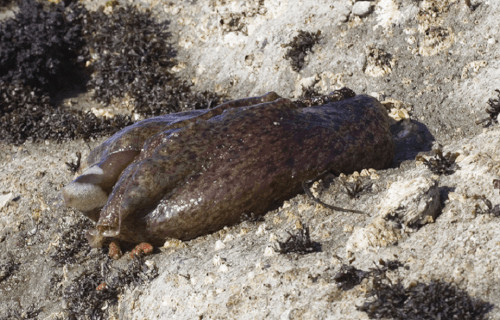
CCL: https://bit.ly/1ryPA8o
California Sea Hare Facts
- The final species appearing in this article about 6 Startling Marine Slugs is the aptly-named California Sea Hare.
- Perhaps most notably, the informative term excellently serves as the common name of a remarkable variety of sea slug. Not only that, but the scientific name of the animal also provides a clue to where the species lives.
- However, though, this remains the somewhat difficult to pronounce term of the Aplysia californica. But, regardless of which of these terms you use to speak of it, this truly fascinating marine invertebrate represents a most impressive creature.
- Quite fortunately for those who appreciate it, the amazing California Sea Hare also appears to currently be maintaining a sufficient, and relatively stable, population. Plus, this appears to hold true throughout the entirety of its range of habitation.
- The problem, though, is the fact that the region of the world in which it appears remains severely limited. Regardless of the latter, though, the IUCN presently has no listing for the animal on its Red List of Threatened Species.
- The remarkable sea slug must nonetheless be considered to be especially vulnerable at this time. This sad situation further occurs due to two specific factors. Not surprisingly, these are the same two currently facing many species.
- Firstly, the limited range of the wonder of Nature now renders it particularly vulnerable to the peril of habitat loss. Secondly, however, this impressive invertebrate remains especially at risk from the ongoing effects of climate change.
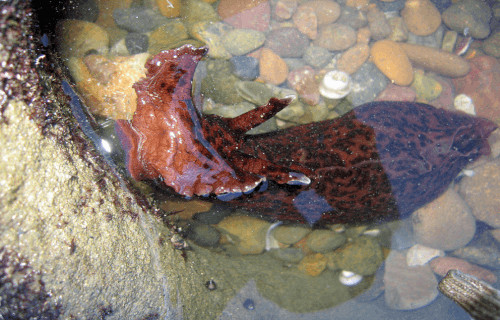
CCL: https://bit.ly/1ryPA8o
California Sea Hare Physical Description
First of all, the amazing California Sea Hare ranks as a moderate-sized type of sea slug. That holds true due to the fact that mature specimens attain an average length of approximately 8 in (20 cm). An average adult weight further equals roughly 2.2 lb (1 kg).
But, exceptional individuals do occur. In fact, some individuals achieve lengths of as much as 16 in (40 cm), and weights of up to 5 lb (2.3 kg). Unlike many species, this invertebrate displays no noticeable degree of the physical characteristic of sexual dimorphism.
Adults of both genders display identical physical traits. Its coloring, varies significantly between individuals. But, most specimens of the California Sea Hare show shades ranging between greenish-brown to reddish-brown. It also boasts four tentacles near the head.
- Kingdom: Animalia
- Phylum: Mollusca
- Class: Gastropoda
- Order: Heterobranchia
- Family: Aplysiddae
- Genus: Aplysia
- Species: A. californica
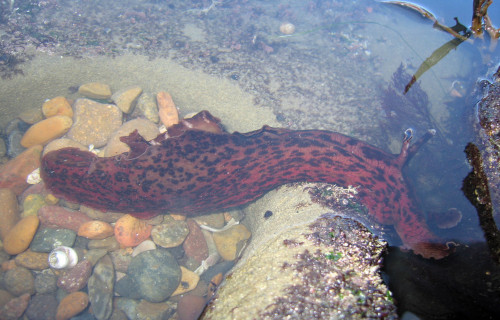
CCL: https://bit.ly/2zGp7Dx
California Sea Hare Distribution, Habitat, and Ecology
Quite sadly, the truly gorgeous California Sea Hare possesses a severely restricted, and also fragmented, range of habitation. This holds true partly because of the regrettable fact that the great majority of its numbers live almost exclusively in one area.
That inhabited area consists of the region along the Pacific coast of the state of California, in the United States, and northern Mexico, in North America. Scattered individuals nevertheless occasionally appear along the beaches of the state of Florida, as well.
But, these possibly represent the last remnants of a vanishing local population. It also inhabits the shallow ocean waters along the coastline. The populations of the creature, to the best of the knowledge of researchers, never live at depths greater than 66.5 ft (20 m).
The remarkable California Sea Hare, like its many related species, evolved as a herbivorous species. In its case, though, it primarily feeds of red algae. As a result of its natural coloring, its own food source provides it with excellent camouflage.
Meanwhile, its own predators remain quite scarce. To be precise, the only known animals to prey on it include the giant green sea anemome, and the ophisto-branch slug. When threatened by a predator, the creature has the ability to release ink, much like an octopus.
This animal also evolved as hermaphroditic. This, allows individuals to act as both male and female. The species generally mates in groups of up to twenty individuals. Finally, it remains comparatively short-lived, possessing an average lifespan of only one year.

CCL: http://bit.ly/2zDnGC2
6 Startling Marine Slugs
We sincerely hope that you have thoroughly enjoyed this article about 6 Startling Marine Slugs. As we hope you have discovered, these amazing species have far more to interest us than many believe.
Sadly, though, many of them now find themselves in peril. It remains up to each of us to do all that we can to protect and preserve these 6 Startling Marine Slugs, and countless other incredible species, for our posterity.
Check out our other articles on 6 Mysterious Natural Phenomena, Earth’s Many Magnificent Marsupials, Sensational Christmas Namesakes of the World, 5 Phenomenal Sea Turtles
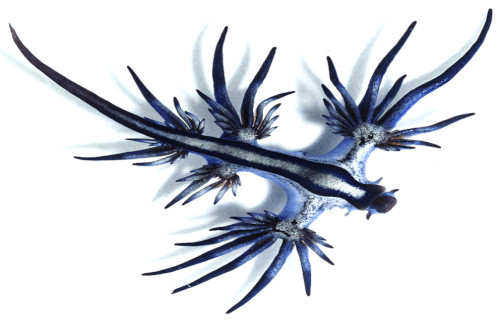
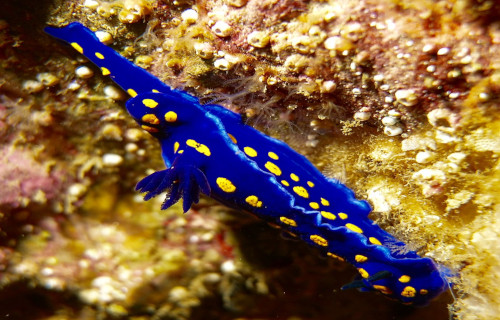









Leave a Reply